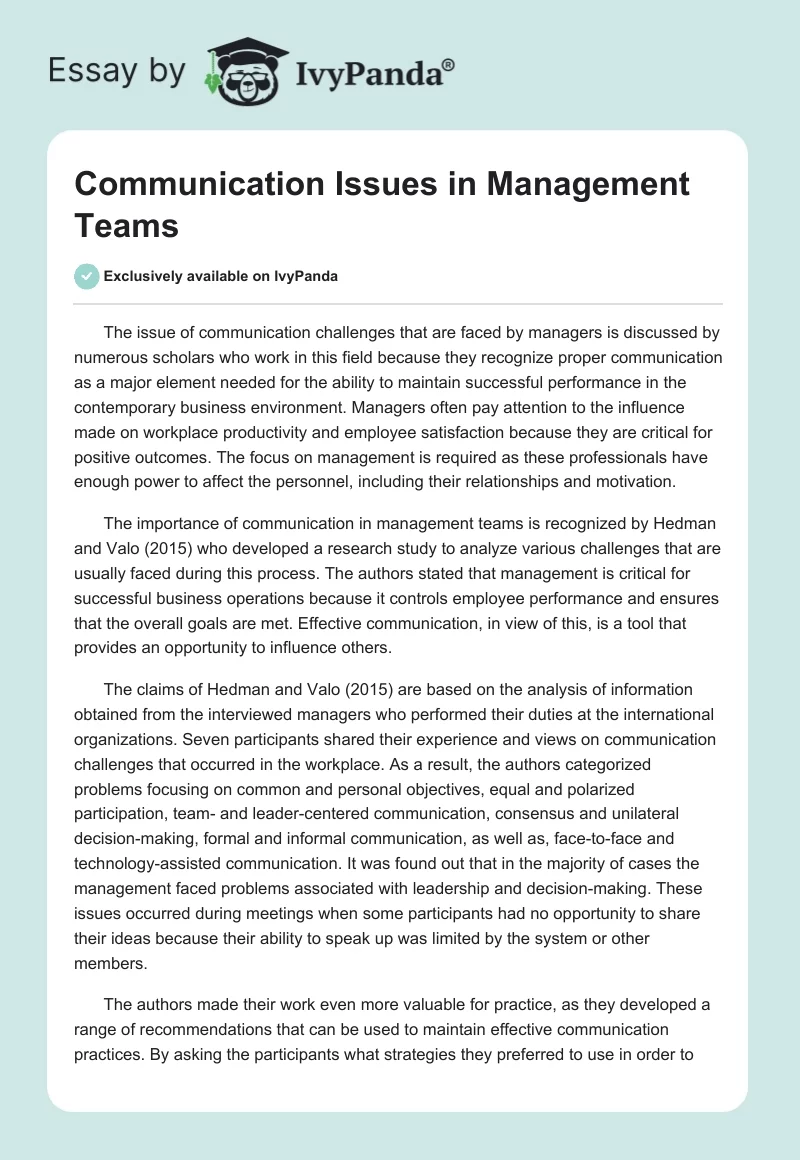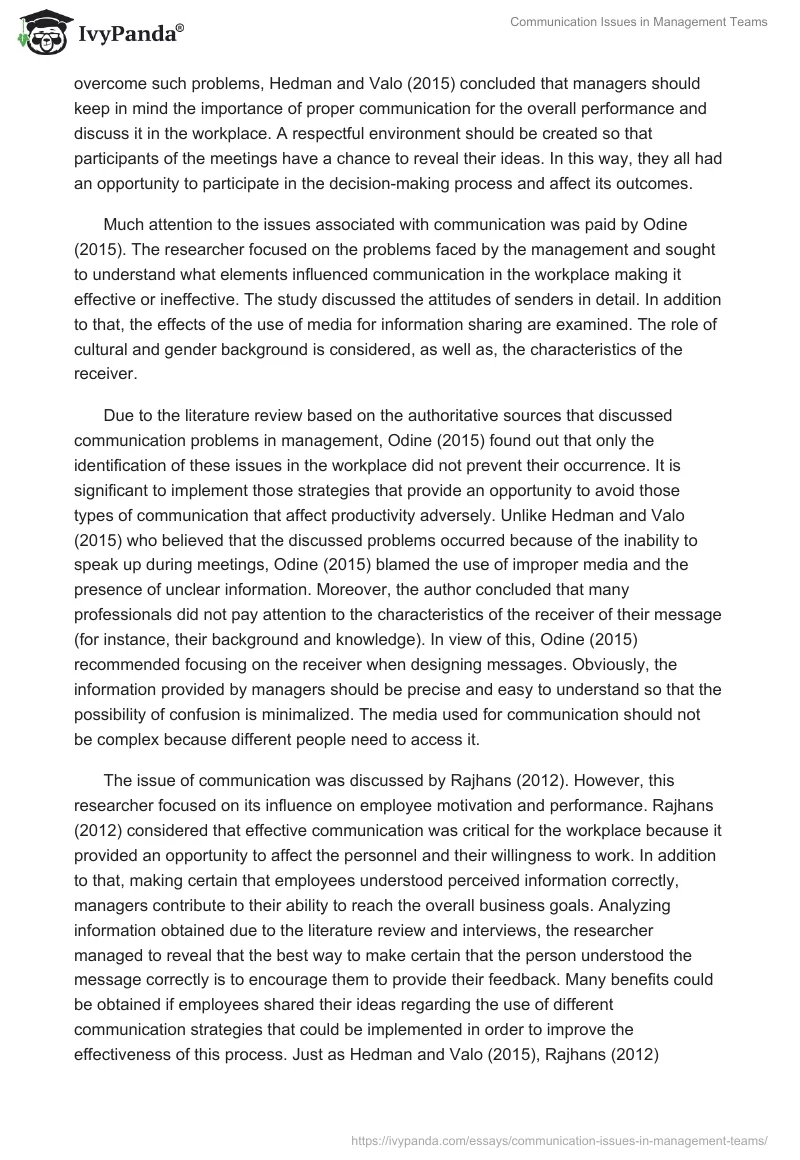The issue of communication challenges that are faced by managers is discussed by numerous scholars who work in this field because they recognize proper communication as a major element needed for the ability to maintain successful performance in the contemporary business environment. Managers often pay attention to the influence made on workplace productivity and employee satisfaction because they are critical for positive outcomes. The focus on management is required as these professionals have enough power to affect the personnel, including their relationships and motivation.
The importance of communication in management teams is recognized by Hedman and Valo (2015) who developed a research study to analyze various challenges that are usually faced during this process. The authors stated that management is critical for successful business operations because it controls employee performance and ensures that the overall goals are met. Effective communication, in view of this, is a tool that provides an opportunity to influence others.
The claims of Hedman and Valo (2015) are based on the analysis of information obtained from the interviewed managers who performed their duties at the international organizations. Seven participants shared their experience and views on communication challenges that occurred in the workplace. As a result, the authors categorized problems focusing on common and personal objectives, equal and polarized participation, team- and leader-centered communication, consensus and unilateral decision-making, formal and informal communication, as well as, face-to-face and technology-assisted communication. It was found out that in the majority of cases the management faced problems associated with leadership and decision-making. These issues occurred during meetings when some participants had no opportunity to share their ideas because their ability to speak up was limited by the system or other members.
The authors made their work even more valuable for practice, as they developed a range of recommendations that can be used to maintain effective communication practices. By asking the participants what strategies they preferred to use in order to overcome such problems, Hedman and Valo (2015) concluded that managers should keep in mind the importance of proper communication for the overall performance and discuss it in the workplace. A respectful environment should be created so that participants of the meetings have a chance to reveal their ideas. In this way, they all had an opportunity to participate in the decision-making process and affect its outcomes.
Much attention to the issues associated with communication was paid by Odine (2015). The researcher focused on the problems faced by the management and sought to understand what elements influenced communication in the workplace making it effective or ineffective. The study discussed the attitudes of senders in detail. In addition to that, the effects of the use of media for information sharing are examined. The role of cultural and gender background is considered, as well as, the characteristics of the receiver.
Due to the literature review based on the authoritative sources that discussed communication problems in management, Odine (2015) found out that only the identification of these issues in the workplace did not prevent their occurrence. It is significant to implement those strategies that provide an opportunity to avoid those types of communication that affect productivity adversely. Unlike Hedman and Valo (2015) who believed that the discussed problems occurred because of the inability to speak up during meetings, Odine (2015) blamed the use of improper media and the presence of unclear information. Moreover, the author concluded that many professionals did not pay attention to the characteristics of the receiver of their message (for instance, their background and knowledge). In view of this, Odine (2015) recommended focusing on the receiver when designing messages. Obviously, the information provided by managers should be precise and easy to understand so that the possibility of confusion is minimalized. The media used for communication should not be complex because different people need to access it.
The issue of communication was discussed by Rajhans (2012). However, this researcher focused on its influence on employee motivation and performance. Rajhans (2012) considered that effective communication was critical for the workplace because it provided an opportunity to affect the personnel and their willingness to work. In addition to that, making certain that employees understood perceived information correctly, managers contribute to their ability to reach the overall business goals. Analyzing information obtained due to the literature review and interviews, the researcher managed to reveal that the best way to make certain that the person understood the message correctly is to encourage them to provide their feedback. Many benefits could be obtained if employees shared their ideas regarding the use of different communication strategies that could be implemented in order to improve the effectiveness of this process. Just as Hedman and Valo (2015), Rajhans (2012) concluded that the cooperation between the management and the personnel has positive influences on the decision-making process. Their mutual cooperation provided additional opportunities to reach organizational goals and business success.
The author emphasized that the participants of communication need to ensure that it is managed as a two-way process because otherwise its effectiveness can be questioned. Unlike Odine (2015) or Hedman and Valo (2015), Rajhans (2012) identified the absence of feedback that follows the instruction as the major communication issue in management. The researcher emphasizes that, in this situation, employees tend to do what they consider to be right instead of meeting goals identified by managers.
The ways to achieve successful communication are discussed by Zulch (2014). The author focused on the identification of those characteristics that provided managers with an opportunity to develop a successful practice. Much attention was paid to the identification of the leadership style because it affected the way professionals interact with others. The researcher presupposed that being aware of different styles and their characteristics, managers could realize how they affected interaction among employees. Moreover, managers received an opportunity to adapt their leadership so that it benefits their practice. Zulch (2014) encouraged professionals to develop their communicational skills because they were significant for appropriate delegation and coordination. While supporting Odine’s (2015) perception of the significance of senders’ attitudes, Zulch (2014) added that their behavior and personality are also critical to consider. Managers are responsible for the focus of employees’ performance on the overall business goals. Thus, they should start improving communication with personal changes.
The use of a people-oriented approach allows making management successful and effective. In view of this, professionals should listen to the personnel and provide them with the information that can be easily understood. Employees are to be encouraged to take part in the decision-making process and to share their vision of the discussed issues. Trustful relationships should be used as the basis of successful practice.
Conrad (2014) believed that business could not be practiced without workplace communication because it ensures that the personnel understand organizational goals and implement practices needed to achieve them. At the same time, communication can be used by managers as a tool of persuasion that makes employees accept the manager’s views and work according to the provided plan. The author emphasized that not all people can manage communication effectively and efficiently. It is significant to be confident and focused and to provide rational and credible information. Thus, it is possible to claim that Conrad’s (2014) views supported Zulch’s (2014) ideas regarding the value of managers’ personal characteristics and Odine’s (2015) considerations associated with the importance of the quality of information. Conrad (2014) stated that communication skills allow professionals to appeal to employees and make them feel respected.
The greatest value of Conrad’s (2014) work is that it includes several case studies. The author identified communicational issues that were described in them and provided recommendations considering their improvement. All this information can definitely be used to improve practice. Conrad (2014) believed that the major challenges faced by the workers were caused by the limited ability to learn and used effective communication strategies. Thus, the author encouraged managers and employees to focus on the development of their skills. Moreover, the researcher identified the use of technology as a possible source of complications associated with the interaction between managers and the personnel, supporting Odine’s (2015) ideas. He shared personal views on bad communication practices but also supported them with authoritative sources.
Husain (2013) based his work on the discussion of the significance to maintain effective communication in the workplace. However, unlike other authors, the researcher focused on the influences made on the organizational changes. Husain (2013) considered that communication between managers and employees affects the willingness of the last ones to perform their duties appropriately. The implementation of changes with a company is often associated with numerous problems, such as increased costs and alteration of practices. Nevertheless, employee resistance is believed to be the most critical issue in this perspective. Effective communication, on the other hand, provides an opportunity to affect the personnel, change their attitudes, and enhance motivation. Supporting the ideas revealed by other authors, Husain (2013) mentioned that it is critical for managers to deliver clear and trustworthy information, as well as, to develop their communicational skills. Employees should be able to participate in the decision-making process, and their ideas should be recognized for professionals to feel respected. Only this way the successful performance can be achieved.
This research study is developed using qualitative research methods. In particular, the work is based on the information obtained with the help of the literature review and interviews (Creswell, 2014). Even though this approach does not provide an opportunity to obtain precise data, it is the most appropriate for the selected topic because rather broad issues are considered. As the information is provided by the participants, it is expected to be affected by their personal biases. However, it does not seem to be a critical problem. Moreover, those research studies that are discussed in the literature review are all based on the qualitative approach. The purpose of the paper is to identify what communication issues occur, why they are observed, and how they can be overcome. In view of this, research should be based on exploration and discussions. Numerical data can help to identify the most commonly observed problems, their causes, and resolutions, but the essence of the topic cannot be revealed using quantitative methods.
References
Conrad, D. (2014). Workplace communication problems: Inquiries by employees and applicable solutions. Journal of Business Studies Quarterly, 5(4), 105-116.
Creswell, J. W. (2014). Research design: Qualitative, quantitative, and mixed methods approaches (4th ed.). Thousand Oaks, CA: Sage.
Hedman, E., & Valo, M. (2015). Communication challenges facing management teams. Leadership & Organization Development Journal, 36(8), 1012-1024.
Husain, Z. (2013). Effective communication brings successful organizational change. The Business & Management Review, 3(2), 43-50.
Odine, M. (2015). Communication problems in management. Journal of Emerging Issues in Economics, Finance, and Banking, 4(2), 1615-1630.
Rajhans, K. (2012). Effective organizational communication: A key to employee motivation and performance. Interscience Management Review, 2(2), 81-86.
Zulch, B. (2014). Leadership communication in project management. Procedia – Social and Behavioral Sciences, 119(2014), 172-181.


